Did you know that selective attention peaks in adults at age 40 and then gradually declines with age1? This fact shows how vital it is to know and boost our focus in today’s world. I’m exploring the science behind attention, a key skill that affects our daily life and productivity.
In our digital era, focus is a rare asset. Studies reveal that too much screen time can hurt our ability to concentrate, remember things, and complete tasks2. Distractions come from outside, like the environment, and inside, like stress or tiredness2.
But, there’s hope. Cognitive science gives us ways to get better at focusing. It says that better attention comes from three parts: attention, working memory, and setting goals2. By knowing these, we can find strategies to improve our focus and beat distractions.
Our focus isn’t just about age or screen time. Things like hunger, sleep, and diet also affect how well we concentrate. For example, not sleeping well can make it hard to focus on hard tasks, but eating right can help1. These facts from cognitive science show us how to get better at paying attention every day.
Key Takeaways
- Selective attention peaks at age 40 and declines later
- Digital distractions greatly affect focus and concentration
- Cognitive control includes attention, working memory, and goal setting
- Sleep, diet, and exercise impact attention span
- Knowing these can help us focus better in daily life
Understanding Attention: The Foundation of Focus
Attention is a complex process that lets us focus on certain info while ignoring others. It’s key to learning, working, and interacting with our world.
Defining Attention in Cognitive Science
In cognitive science, attention is seen as a set of mechanisms that pick out what to process. Studies show it’s vital for focusing on what matters and ignoring the rest3. This process includes alerting, covert attention, and executive control3.
The Importance of Attention in Daily Life
Attention is crucial every day, affecting learning, decision-making, and more. It helps us handle complex situations, work better, and connect with others. Visual working memory, key for storing and choosing stimuli, shapes our actions and behavior3.
Types of Attention: From Selective to Executive
There are different types of attention, each with its own role in our thinking. These include:
- Selective attention: Focusing on one thing while ignoring others
- Divided attention: Handling several tasks at once
- Sustained attention: Keeping focus for a long time
- Executive attention: Setting priorities and switching tasks
Knowing these types helps us improve focus and get more done. Tools like HappyNeuron Pro offer exercises to boost attention4. Using these tools regularly might make our brains more adaptable, helping us focus better4.
| Type of Attention | Description | Example |
|---|---|---|
| Selective | Focusing on one stimulus | Reading in a noisy café |
| Divided | Managing multiple tasks | Cooking while talking on phone |
| Sustained | Maintaining long-term focus | Watching a lengthy lecture |
| Executive | Task prioritization and switching | Managing a project timeline |
By grasping these attention types and their roles, we can find ways to boost our focus and productivity in life.
The Neuroscience Behind Attention
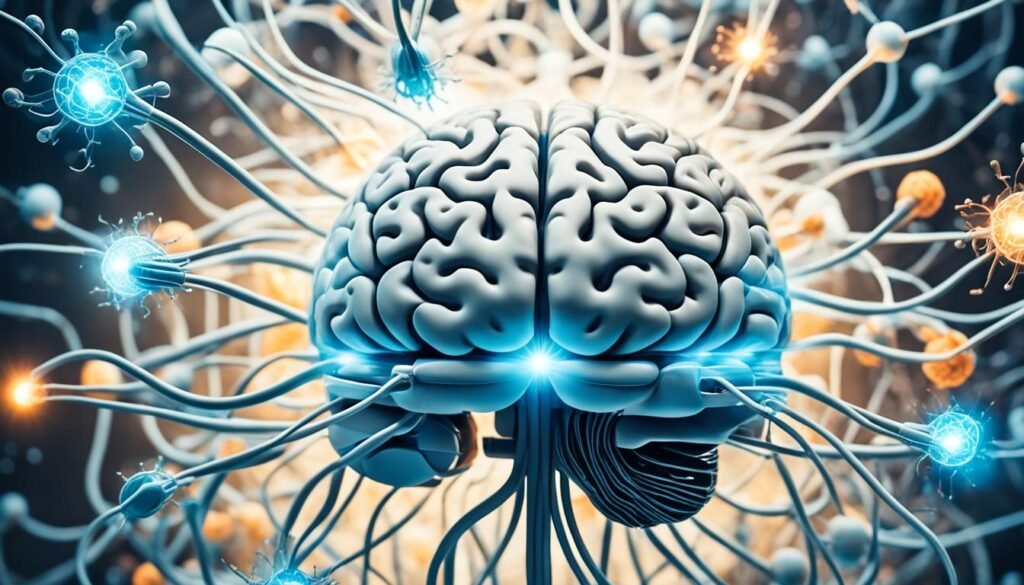
The brain is the core of attention, and neuroscience shows us how it functions. Attention is a key topic in psychology, neuroscience, and machine learning. It shows how vital it is in many areas5. When we explore the brain, we learn that attention means managing our limited mental resources flexibly5.
Dopamine is essential for our thinking and focus. This chemical helps us stay motivated, feel pleasure, and concentrate. Without it, tasks might seem dull, making it tough to concentrate.
Scientists use tools like EEG, fMRI, and MEG to study attention. These methods help us see what happens in our brains when we focus6. Their findings show that attention involves more than just focusing. It also includes being alert and vigilant, which affects our performance on challenging tasks56.
Visual attention is a major area of study in neuroscience. Our eyes and brain work together to spot what’s important. Some things naturally grab our attention, like bright colors or moving objects6. Knowing this helps us understand why some things catch our eye and others don’t.
Learning about the neuroscience of attention helps us find ways to improve our focus and thinking. This knowledge is useful for students, workers, and anyone looking to do better.
Attention in the Modern World: Challenges and Distractions
In today’s fast-paced digital age, keeping our focus is hard. Our attention spans have gotten much shorter over time. In 2004, we could focus on screens for about 2.5 minutes. But by 2020, it was down to just 47 seconds78. This shows how digital distractions are affecting our brains.
Digital Distractions and Their Impact
Smartphones and other devices make it tough to focus. Even having a phone nearby can lower our thinking power9. We get hit with so much info, it’s hard to stick with one task.
Environmental Factors Affecting Focus
Where we work affects how well we focus. Remote workers often find it harder to stay motivated than office workers8. Making a space that helps us concentrate is important for better focus.
Multitasking Myth: The Cost of Divided Attention
Many of us think we’re good at multitasking, but it’s not without its downsides. Switching between tasks increases stress and mistakes7. For example, people check their emails about 77 times a day, which adds to stress8.
“Multitasking is the enemy of focus. Each task switch comes with a cognitive cost.”
To fight these challenges, we need to know how we naturally focus best. Most people focus best in the morning and late afternoon8. By doing our most critical tasks during these times, we can work better and reduce distractions.
Understanding these challenges is the first step to getting our focus back in a world full of distractions.
Cognitive Control: The Key to Improved Focus
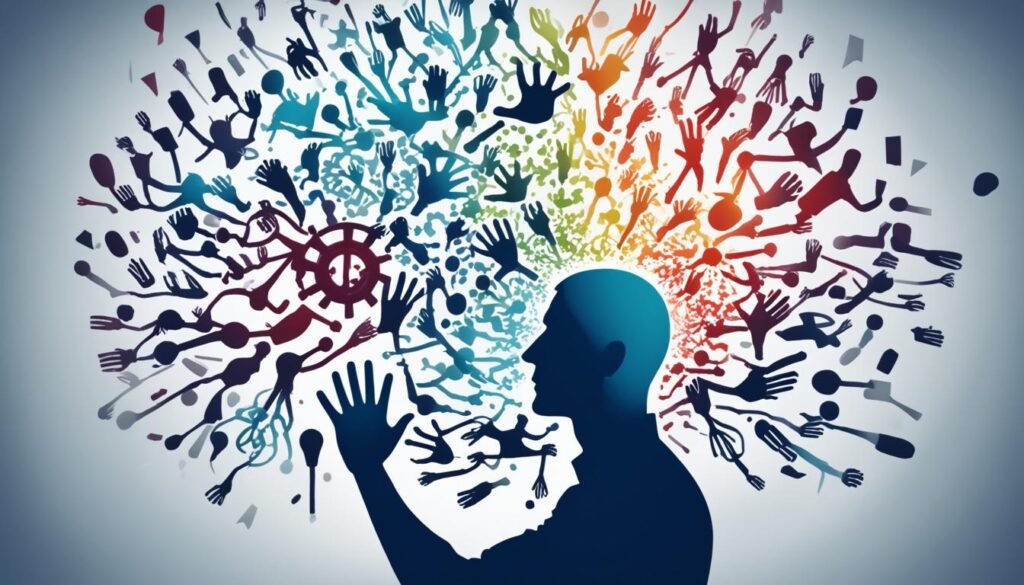
Cognitive control helps us manage our attention and achieve our goals. It acts like the brain’s traffic controller, directing our thoughts. Studies highlight three main parts: setting goals, using working memory, and focusing10.
Distractions can lower our brain’s performance. Things like phone buzzes or loud noises make us lose focus10. Trying to do many things at once can harm our brain’s connections10.
To fight distractions, we must improve our top-down attention. This focused attention uses our prefrontal cortex to keep us on track10. Research shows that better cognitive control helps us focus better in work, school, and everyday life.
Effective goal-setting influences attention and working memory for task completion.
Clear goals boost our cognitive control. They guide our focus and memory, making our brains work better10. By reducing distractions, we can greatly improve our focus and control10.
In today’s distracting world, improving our cognitive control is key. By understanding how attention and goal-setting work together, we can achieve better focus and productivity.
The Role of Working Memory in Attention
Working memory is key to our focus and processing information. It’s like a mental workspace where we hold and change data briefly. Knowing how it works can boost our thinking skills and sharpen our focus.
Understanding Working Memory
Working memory is linked to attention and short-term memory. It helps us keep info in mind during complex tasks. Studies show the prefrontal cortex uses the same neurons for attention and working memory11. This connection between attention and working memory is real, sharing brain mechanisms11.
Enhancing Working Memory for Better Focus
Boosting working memory can improve focus and how we process information. Research finds time limits and sharing resources impact working memory and performance12. To improve working memory:
- Practice memory exercises regularly
- Reduce distractions in your environment
- Break information into smaller, manageable chunks
Strategies to Optimize Working Memory
To make the most of working memory, know its limits and how it works. Studies show we can only focus on a few things at once, showing our cognitive limits12. Here are ways to use your working memory better:
| Strategy | Description |
|---|---|
| Chunking | Group related information into meaningful units |
| Visualization | Create mental images to represent information |
| Active Recall | Regularly test yourself on information you’re trying to remember |
By using these strategies and understanding working memory, we can greatly improve our thinking and focus every day.
Goal Management: Aligning Focus with Intentions
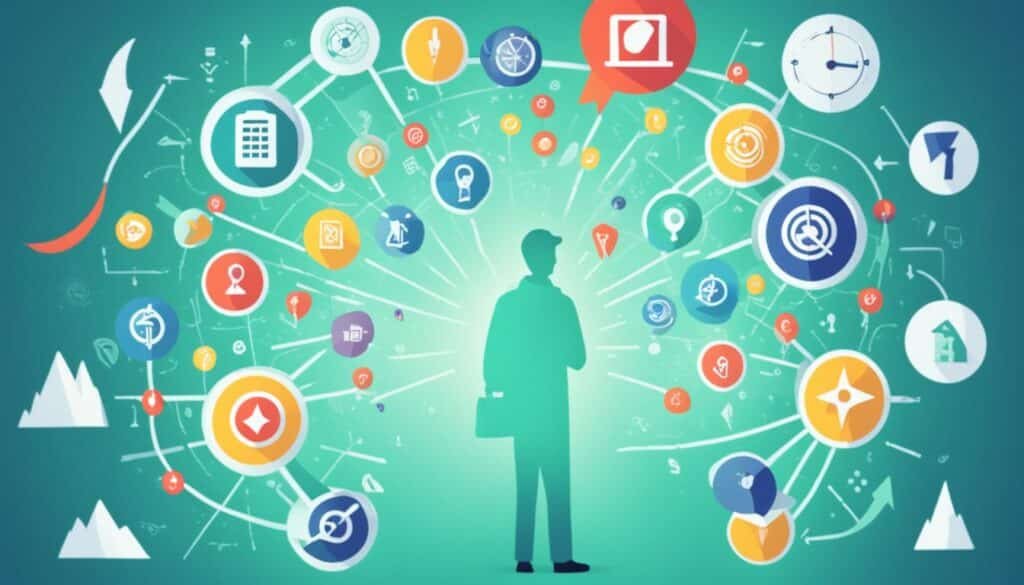
Setting goals is key to success. When we set clear intentions, we get more motivated and energized to achieve our goals13. This focus helps us see things more clearly and aim for what we want13.
Getting tasks in order is vital for managing goals. I’ve found that a tidy workspace helps me concentrate on tough tasks14. It makes it easier to sort out what’s important and work on my main goals.
Being flexible in our thinking is important when we have many goals. I use visualization to motivate myself and stay on track with daily tasks that help me reach my goals13. This way, I can adjust to new situations and keep my focus on my goals.
Only about 8% of people achieve their self-set goals each year14. To do better, I take short breaks to avoid burnout and boost my productivity14. I also believe in managing my energy well for better performance and personal growth14.
“Declaring intentions passionately can help individuals take action more effectively towards their goals.”
By balancing intention and attention, I’ve made achieving success and freedom easier13. Being mindful has sharpened my focus and helped me stay on track when things distract me14. Aligning my focus with my intentions is a strong way to reach my goals.
Attention and Learning: Maximizing Educational Outcomes
Understanding how attention affects learning is key to better education. It changes how we teach and how students engage with material.
Attention’s Impact on Information Retention
Children’s focus changes with age. They can focus on one task for about two to five minutes per year of age15. This fact helps teachers plan lessons to help students remember more.
Starting lessons with 15 minutes of fun activities can make students more interested in hard tasks15.
Strategies for Educators to Enhance Student Focus
Teachers can use several strategies to keep students focused:
- Break tasks into smaller pieces for students struggling with attention15
- Use classroom games to help kids focus on hard tasks15
- Check in with students often to keep them on track15
These methods can really help students pay attention and remember more. Studies show that meeting children’s needs in all areas helps them do better in school.
Self-Directed Learning and Attention Skills
Teaching students to learn on their own can improve their focus. A study showed that students who did 2.5 hours of focus training over 22 days felt better about their focus16. They also paid less attention to distractions in class and everyday life16.
“Attention is the foundation of all higher cognitive and emotional abilities.”
Here’s how student involvement affects their learning:
| Aspect | Impact on Learning |
|---|---|
| Behavioral Engagement | Positively correlates with school completion |
| Emotional Engagement | Improves school identification |
| Cognitive Engagement | Boosts academic performance |
Getting students involved early in college is very important. Not doing well in key courses can lead to leaving school17. By focusing on attention and involvement, we can greatly improve learning outcomes at all levels.
The Attention Economy: Navigating Information Overload

In today’s digital world, we face a big challenge: the attention economy. This idea shows how hard it is to get our focus in a world full of information. The global net advertising revenue reached $853 billion in 2023, showing how much value is put on getting our attention18.
We get hit with a lot of content every day, which makes it hard to keep things in context. We have to constantly decide what to pay attention to18. This affects our relationships, what we learn, our health, and our happiness.
The attention economy tries to give us content that matches our interests18. While it’s handy, it also has its downsides. Social media algorithms aim to keep us hooked, making more money for the platforms through ads19.
Too much information can overwhelm us and make it hard to make decisions, hurting our productivity19. The fast pace of content makes it tough to focus on complex topics for long19.
“In the attention economy, our focus is the most valuable currency.”
To deal with this, we need to get better at using digital tools and managing our attention. These skills help us sort through information, stay focused, and avoid getting overwhelmed.
| Challenges | Solutions |
|---|---|
| Information overload | Develop strong filtering techniques |
| Shortened attention spans | Practice mindful consumption of content |
| Filter bubbles | Seek diverse perspectives actively |
| Privacy concerns | Be mindful of data sharing |
By understanding the attention economy and getting the right skills, we can take back control of our focus. This helps us make better choices about how we use the digital world.
Mindfulness and Attention: Cultivating Present-Moment Awareness
Mindfulness meditation helps us focus better. It trains our minds to stay sharp and alert, even when there are many distractions.
Mindfulness Meditation Techniques for Focus
Simple techniques can greatly improve our focus. One good method is the box breath technique. Breathe in for four counts, hold for four, exhale for four, and pause for four. Do this cycle four times to focus on the now20.
Studies show that mindfulness can make us healthier and more focused21. By setting aside time for these practices, we boost our mental clarity and thinking skills.
Integrating Mindfulness into Daily Routines
Adding mindfulness to our daily life is easy. Try using a visual reminder, like a sticker with “Presence” on it, in places you often see. This helps you stay mindful20. As you get better at it, you’ll naturally stay mindful all day.
“The present moment is filled with joy and happiness. If you are attentive, you will see it.” – Thich Nhat Hanh
The Science Behind Mindfulness and Attention
Research says mindfulness helps us control ourselves and change our habits for the better21. It’s interesting that most people spend almost half their day daydreaming, which can make them less happy20. Mindfulness can help us stop daydreaming and feel better overall.
| Mindfulness Practice | Benefits |
|---|---|
| Box Breathing | Improves focus, reduces stress |
| Visual Reminders | Builds habit of presence |
| Daily Mindfulness | Enhances overall well-being |
By using these Mindfulness Practices, we can become more aware of the present moment. This improves our focus and makes our lives better. The science proves that mindfulness is a great way to focus and live a better life.
Technology and Attention: Friend or Foe?

Digital technology has changed our lives in big ways. But, it affects our attention in both good and bad ways. For example, 78% of students say technology helps them stay focused in class22. But, 89% of parents worry it distracts them during school22. This shows how complex the link between tech and attention is.
Tools and apps aimed at managing our attention have come to the forefront. They try to help us deal with distractions. For instance, working for 52 minutes and then taking a 17-minute break is shown to be effective23. Many apps now use this method to help us concentrate better.
But, not everyone is convinced these tools work well. While 82% of teachers think technology helps students learn, 56% of parents worry it distracts them22. This shows we need to use technology wisely.
“Technology is a useful servant but a dangerous master.” – Christian Lous Lange
To make the most of technology without its downsides, try these tips:
- Use productivity apps to track and manage your time
- Implement digital minimalism techniques
- Set boundaries for technology use
- Practice regular digital detoxes
By following these steps, we can turn technology into a tool that helps us focus and be more productive.
| Aspect | Positive Impact | Negative Impact |
|---|---|---|
| Learning Engagement | 78% of students more engaged | 89% of parents worried about distractions |
| Teacher Perspective | 82% believe in positive impact | 45% concerned about technical issues |
| Productivity | 52/17 work-break cycle boosts efficiency | Digital overload challenges productivity |
Attention Training: Exercises to Sharpen Focus

We’ve found many ways to improve our focus through attention training. These methods help us concentrate better in our everyday tasks.
Cognitive Training Games and Apps
Brain games are now popular for training our minds. Apps like Lumosity and Brain Age aim to boost our focus, memory, and quick thinking. They might help children with ADHD and older adults, but their benefits for healthy young adults are still being debated24.
Studies from the University of Cambridge show that brain training can really improve focus. People who did these exercises did better in attention tests. Their skills got as good as those who took ADHD drugs25.
Physical Exercise and Its Impact on Attention
Exercise is great for our focus. Kids who moved around before tests did better than those who didn’t. It helps us ignore distractions, which is key to staying focused24.
Nutrition and Lifestyle Factors for Optimal Focus
What we eat and how we live affects our focus. Here are some important tips:
- Adequate sleep
- Stress management techniques
- Balanced diet rich in brain-boosting nutrients
- Hydration
Practicing mindfulness all day can help us concentrate better and cut down on distractions. Just 10 to 20 minutes of mindfulness meditation a day can make us more focused and improve our thinking skills24.
| Attention Training Method | Benefits | Time Commitment |
|---|---|---|
| Brain Training Games | Improved memory, concentration, problem-solving | 15-30 minutes daily |
| Physical Exercise | Enhanced focus, better distraction management | 30 minutes, 3-5 times a week |
| Mindfulness Meditation | Increased attention span, reduced stress | 10-20 minutes daily |
Adding these exercises to our daily life can make us better at focusing and handling distractions. This not only helps us concentrate better but can also open up new career paths and make life more fulfilling2425.
Attention Disorders: Understanding ADHD and Other Conditions
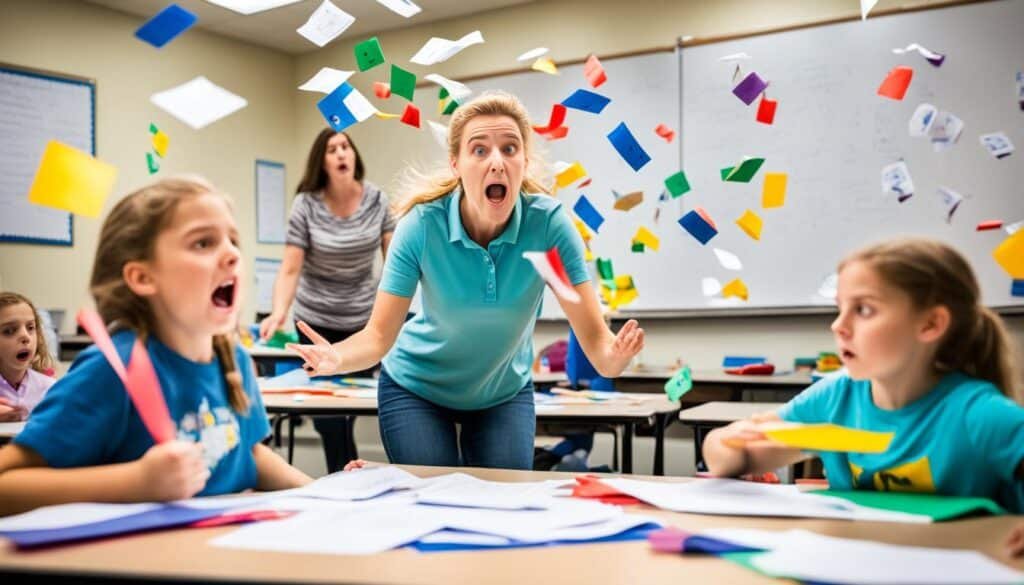
Attention disorders, especially ADHD, can make it hard for people to focus and manage daily tasks. ADHD usually starts in childhood and can last into adulthood26. To get diagnosed, symptoms must start before age 12 and affect social or school life26.
Kids with ADHD often show too much energy and act on impulse. These signs can start as early as ages 3 to 6, making school and social life tough2726. As they get older, the focus issues become more common in school, while the hyperactivity lessens in teens27.
ADHD often goes with other mental health issues. Kids with ADHD might also have behavior problems, anxiety, or depression28. These extra conditions make diagnosing and treating ADHD harder, so getting full mental health care is key.
Handling ADHD usually means using a mix of medicine and talk therapy. Most of the time, doctors prescribe stimulants, but there are other options too2726. Things like behavioral therapy, cognitive behavioral therapy, and teaching families how to help have been proven to work well26.
| Age Group | Predominant Symptoms | Common Treatments |
|---|---|---|
| Young Children (3-6 years) | Hyperactivity, Impulsivity | Behavioral therapy, Parent education |
| Elementary School Age | Inattention, Academic struggles | Medication, School-based interventions |
| Adolescents | Inattention, Impulsivity, Restlessness | Medication, Cognitive behavioral therapy |
| Adults | Inattention, Restlessness, Impulsivity | Medication, Psychosocial interventions |
It’s important to understand ADHD and other attention issues to diagnose and treat them right. With the right support and treatment, people with these conditions can better focus, control their symptoms, and live a good life.
The Pomodoro Technique and Other Time Management Strategies
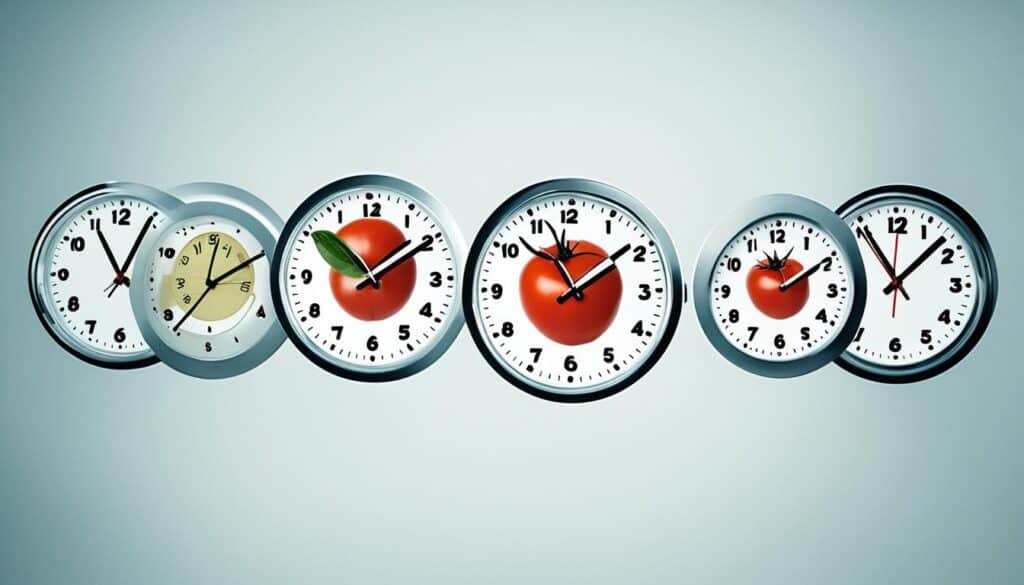
Managing time well is key to being productive and focused in today’s fast world. The Pomodoro Technique is a great way to do this. It means working in 25-minute chunks, or pomodoros, with short 5-minute breaks in between. After four pomodoros, you get a break of 15-30 minutes29.
This technique makes focusing easier, keeps distractions away, stops burnout, and boosts motivation. It suggests breaking big projects into smaller steps and doing simple tasks together29.
Other ways to be more productive include:
- The 80/20 rule (Pareto Analysis): 20% of actions are responsible for 80% of outcomes
- Eisenhower Matrix: Sort tasks into urgent-important quadrants
- Time Blocking Method: Allocate specific tasks to time blocks throughout the day
- Eat That Frog Technique: Tackle difficult tasks first to increase productivity30
These strategies help set goals, prioritize tasks, and stay focused despite distractions. Sadly, only about 10% of people have clear goals, showing the importance of better time management31.
Try out different techniques to see what suits you best. The main thing is to be consistent and adjust these methods to fit your work style and needs.
Creating Attention-Friendly Environments: Home and Work
In today’s fast-paced world, it’s key to make spaces that help us focus and stay productive. Thoughtful design of our workspaces can greatly help us concentrate, especially with more people working from home lately. Designing spaces for optimal focus means looking at both the physical and mental aspects of our surroundings.
Designing Spaces for Optimal Focus
When making a workspace, I focus on cutting down on distractions and boosting focus. This means having separate areas for work, especially if you live with others. Setting clear boundaries helps reduce interruptions and makes it easier to focus on tasks32.
Managing Digital Distractions in Your Environment
Strategies for reducing tech use are key in our digital age. I suggest having tech-free zones and times for checking emails and messages. This helps fight the idea of multitasking, which can lower our response speed and increase mistakes32. Focusing on one task at a time boosts our memory and productivity.
The Impact of Nature on Attention and Focus
Adding nature to our work and living areas can deeply affect our thinking and focus. Natural light, plants, and nature-inspired art can make spaces more relaxing and conducive to focus. This fits with how our brains change and adapt, helping us stay attentive33. By designing with nature in mind, we can make spaces that support both work and well-being.
FAQ
What is attention, and why is it important?
Attention means focusing on certain information while ignoring others. It’s key for survival, learning, and staying productive. It helps our brains work well.
What are the different types of attention?
There are four main types of attention. Selective attention focuses on one task. Divided attention handles multiple tasks at once. Sustained attention keeps focus over time. Executive attention prioritizes tasks.
How does the brain regulate attention?
The brain uses dopamine to manage attention, motivation, and pleasure. Knowing how attention works can help us improve our focus.
What challenges do modern distractions pose to attention?
Today’s distractions, like digital devices and multitasking myths, reduce our focus. They make it hard to stay attentive.
What is cognitive control, and how does it relate to attention?
Cognitive control helps us choose what to think and do. It includes attention, memory, and setting goals. It helps us stay on track.
How can working memory be optimized to enhance attention?
To boost working memory, try memory exercises, reduce distractions, and break tasks into smaller parts.
Why is goal management important for maintaining focus?
Good goal management helps us focus on what we want to achieve. It lets us switch tasks smoothly and know when to come back to the main task.
How can educators and students improve attention in learning environments?
Teachers can make lessons engaging and reduce distractions to help students focus. Students can improve focus through self-learning techniques.
What is the attention economy, and why is it relevant?
The attention economy is about the fight for our attention in the digital world. Learning to deal with information overload is crucial.
How can mindfulness practices improve attention?
Mindfulness meditation can change how our brains work, making us more focused and alert. Adding mindfulness to our daily life helps us stay in the moment.
Can technology be used to improve attention and focus?
Technology can distract us, but tools like productivity apps and minimalism can help us focus better.
What exercises and lifestyle factors can help sharpen focus?
Games, exercise, healthy eating, enough sleep, and managing stress can all improve our focus.
How do attention disorders like ADHD impact focus and concentration?
ADHD can make it hard to focus. Getting the right diagnosis and treatment is key to improving focus and life quality.
How can time management strategies like the Pomodoro Technique improve focus?
Techniques like the Pomodoro Technique, which involve focused work followed by breaks, can boost focus and productivity.
How can the physical environment be optimized for better attention and focus?
Creating spaces with fewer distractions and adding nature can help us focus better in work and home areas.
